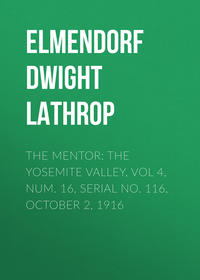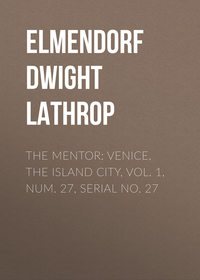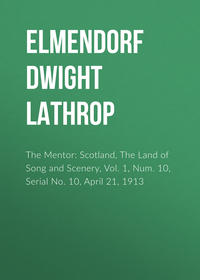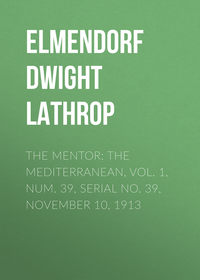 полная версия
полная версияThe Mentor: Holland, v. 2, Num. 6, Serial No. 58
A CITY BUILT ON PILES
The costumes, while not so picturesque as those to be found in the country districts, are interesting to the traveler from other lands. The houses are built on piles driven into the soft soil – a fact that the witty old Erasmus of Rotterdam turned to jest by saying that he knew a city whose inhabitants dwelt in the tops of trees like rooks.
There are so many things in Amsterdam of historic, literary, and art interest that no one can expect to “do the city” and do it thoroughly in the brief time usually allotted by the ordinary tourist. For the student of art there is enough to fill a month’s time. The home city of Rembrandt naturally holds the interest of an artist, and the Ryks Museum contains a wonderful collection of Dutch art and Historic relics.
RYKS MUSEUM
This museum is an impressive stone and brick building, constructed in 1877-1885, and filling nearly three acres of ground. It holds a place among the greatest museums of the world, and in its devotion to its own particular subject – Dutch art and history – it is unique. It is not the lover of art alone who will find the place fascinating: the historian will be held by the military, naval, and colonial collection; the antiquarian will linger over the old works in gold and silver, the models of ships of different periods, antique books and furniture, textiles and stained glass; while the artist will regard the picture galleries as a treasure house.
For the artist, if interested in the Dutch masters of art, the museum is the one particular place in Europe. There about him he will find some of the most celebrated works of Rembrandt, Franz Hals, Paul Potter, Jan Steen (stane), Hobbema (hob´-be-mah), and other Dutch painters.
The picturesque old buildings of Amsterdam, especially those in the inner city, will delight the visitor. Many of these have great historic interest – notable among them Admiral de Ruyter’s (ry´-ter; Dutch, roi´-ter) house, bearing his portrait in relief on its front, and a little beyond that the old Montalbans Tower.
The Royal Palace is a solid building which was begun in 1648, just after the Peace of Westphalia, and was finished in the course of seven years at a cost of 8,000,000 florins ($3,216,000). It is not a beautiful building; but in its structure and its inner equipments it is interesting as showing the character of Dutch life and government. You bring from a visit to the palace an impression of the solidity, power, and the enduring virtues that are the ancestral inheritance of the Hollander.
No visit to Amsterdam is complete without a sight of the Zoölogical Garden, which is one of the best in Europe, and a trip out to the unique little Island of Marken. There in that odd spot you will find all the picturesqueness of Holland in solid deposit. Gaily colored costumes are everywhere; houses are queer in structure and in furnishing; and manners and habits of life are peculiar and interesting. But let the visitor be cautious in Marken. It has of recent years come to be a show place, stocked with all sorts of Dutch articles of no special value, most of which are manufactured solely to catch the fancy of the unwary tourist.
HAARLEM
On returning from Marken the traveler will find it worth his while to run west to the quaint old town of Haarlem (hahr´-lem). This is the city of the governor of the province of North Holland, and is one of the cleanest and neatest towns in the Netherlands. Its population is something over 70,000, and it has the appearance of prosperity and welfare. During the Middle Ages, Haarlem was the residence of the counts of Holland, and was the scene of several important military engagements between the Dutch and the Spaniards. It is famous for its horticulture, and furnishes bulbs to every country in Europe and North America. Along about the middle of spring a wonderful sight may be seen in the lands surrounding Haarlem. Whole fields of hyacinths, crocuses, anemones, tulips, lilies, etc., offer a brilliant variety of color and fill the air with delicious perfume. It is a feast for the senses indeed!
ROTTERDAM
Situated about thirty miles south of Amsterdam and Haarlem is Rotterdam, the second largest town in the Netherlands, which has a population of about 370,000. To some it is known chiefly as the home of the illustrious Erasmus, who was born there in 1465. In the great marketplace of Rotterdam there stands a fine bronze statue of Erasmus.
To merchants Rotterdam is known as one of the busiest import cities on the Continent; as in its import trade it is exceeded only by Hamburg and Antwerp, while its cattle market is the most important in Holland. There is much life in Rotterdam, and plenty of entertainment to enliven the visitor who goes there for other purposes than those of trade.
Boyman’s Museum contains a most valuable collection of Dutch art, and the churches, parks, and public ways are attractive and interesting. Down at the large docks you will find busy scenes; at the Wilhelmina Kade especially, where the great passenger steamers lie. You will meet that name Kade wherever you go in the towns of Holland. It means quay, and the different thoroughfares distinguished by the name are either quays or else have been quays in times past, and in the course of the city’s growth have become streets with waterways in them.
You will be impressed with the vast multitude of bridges in Rotterdam. I do not know that they actually exceed in number the bridges of Amsterdam; but they appear to, for many can be seen from almost every point of view. The service of the canal to Holland is manifold, and this is true in winter as well as in summer. Over the frozen surface of the canal children skate to school, women skate to their shopping, and those who have time for recreation skim the icy surfaces from town to town in skating trips.
THE HAGUE
There are many towns in Holland to invite the traveler, and most of them will delight him as well. This is especially true of Utrecht, Dordrecht, and Delft, the last famous the world over for its pottery. It is well, however, when making a visit to Holland, to save The Hague until the last.
The Hague is the political capital of Holland, and in some ways the most beautiful and interesting of all Dutch cities. It is a most cosmopolitan town, and its population includes many distinguished people. Among the cities of Holland, The Hague leads in culture and refinement, as Amsterdam and Rotterdam do in commerce. It is, moreover, the most attractive city. In neatness and in cleanliness it is claimed that The Hague cannot be excelled by any city in the world. You are willing to believe that when you are there.
THE HOUSE IN THE WOOD
The full Dutch name of this city of royalty is ’s Graven Hage (’s grah´-fen hah´-ge), which means “the count’s inclosure.” The name was given to it originally when it was a richly wooded plain and a hunting resort of the counts of Holland. It is now the residence of the queen of Holland and the seat of government, where most of the important national transactions of the last three hundred years have taken place. There is no great amount of business at The Hague. It is a place of important political affairs and of social life and enjoyment. The life there is distinguished for its gaiety, and the society for its distinction. Great interest naturally centers in “The House in the Wood,” a most picturesque château erected in 1645 for Princess Amalia, consort of Prince Frederick Henry, son of Henry the Silent. This is the favorite home of royalty. The most interesting apartment in the palace is the Orange Room, which was prepared by the princess as a memorial to her husband, and has been the scene of many important diplomatic and social events. The first International Peace Conference, at which twenty-six powers were represented, met in this room in the summer of 1899. The House in the Wood is beautifully furnished and decorated, and, more than the usual royal residence, it realizes the meaning of the word “home.”
ATTRACTIONS OF THE HAGUE
The population of The Hague is more than 240,000, and it has, besides The House in the Wood, a number of notable features. There is the celebrated picture gallery called the Mauritshuis, the Municipal Museum which, next to the Ryks, is the finest in Holland, the Mesdag Museum, which contains among other art treasures a fine collection of pictures by the Barbizon painters, and the Steengracht Gallery, which is rich in modern French and Dutch paintings. The quaint old Hall of the Knights will attract attention for its historic interest, and so will the beautiful and imposing national monument, which was set up in 1869 to commemorate the restoration of Dutch independence and to honor Prince William Frederick of Orange.
Altogether The Hague is a delight to the traveler. Thackeray exclaimed over it, “The brightest little brick city, with the pleasantest park to ride in, the neatest, comfortable people walking about, the canals not unsweet, and busy and picturesque with life!”
SCHEVENINGEN
It might be Brighton or Margate, and, except for the swarm of hooded beach chairs, it might be Coney Island, this popular seaside resort of Holland. Most of the features familiar to those who frequent the sea coast resorts of other lands are to be found at Scheveningen. There is the wide, gradually shelving beach, ceaselessly washed by the rolling surf, crowded with people of all ages and stations, bobbing in the water, frolicking on the beach, or sedately seated in the shaded chairs. Back on the beach runs the long line of hotels and cottages that we find at all great ocean resorts. The pleasure of playing on the seashore is much the same wherever humanity is found, and no matter what the locality may be the pleasure in all places finds pretty much the same forms of expression.
Scheveningen (shay´-ven-ing-en) began its life as a fishing village away back in 1400. It is situated about three miles from The Hague, and has been a bathing resort since 1815, growing in popularity and population until now the annual number of visitors is about 40,000, chiefly Dutch and German, but including also many Britons and Americans. The season runs from the first of June to the end of September, and, just as in the case of other summer resorts, its activities are at their height about the first of August.
Aside from its many attractions as a summer resort, Scheveningen has some historic interest. It was from there that Charles II set sail when he returned to England to assume the crown at the time of the Restoration. This was in 1660. Thirteen years later that sturdy naval hero Admiral de Ruyter engaged in a sea battle off Scheveningen, and there defeated the combined forces of France and England.
DUTCH COUNTRY LIFE AND PEOPLE
For those who would know Holland and the people, no trip would be complete that merely included a few of the prominent cities. Take your pack if you care for tramping, or engage a car if you prefer to ride: you will find the roads good. Then go through the country and meet the people in their simplest condition. The Dutch farmer has not changed in several hundred years. He is a thrifty, contented individual, and his life will interest you. You will find the country families hospitable, and you will learn much from them that the city Hollanders have not told you. As you go through the farm districts you will be impressed with the varied color and the picturesque qualities of everything. And though you may not be an artist you must, in the course of a sojourn in Holland, feel the stir of art consciousness.
Aptly indeed has Holland been called “a land of untouched pictures.”
SUPPLEMENTARY READING
THE RISE OF THE DUTCH REPUBLIC
J. L. Motley.
HISTORY OF THE UNITED NETHERLANDS
J. L. Motley.
Two justly famous and comprehensive historical works.
MOTLEY’S DUTCH NATION
W. E. Griffis.
A condensation of Motley’s works brought down to 1908.
DUTCH LIFE IN TOWN AND COUNTRY
P. M. Hough.
A well written and authoritative book.
THE AMERICAN IN HOLLAND
W. E. Griffis.
A book that cannot fail to interest.
HOLLAND
George Wharton Edwards.
A book delightfully written, and artistically illustrated by a well known painter.
THE OPEN LETTER
The travel impressions of an artist are always interesting. Mr. George Wharton Edwards in his book, “Holland of Today,” presents with brush and pencil a vivid and attractive picture of life and natural conditions in the Netherlands:
* * *“The first impression that the traveler in Holland gets is in one respect similar to that given by the far western prairie regions, and the broad, wind-swept flat country with comparatively few trees, and lying open to the gales of the North Sea, has a little of the same bare aspect. But with this is mingled a most decided aspect of novelty. Here the fields are cultivated with the care of suburban market gardens, and are separated by long V-shaped ditches, through which the water runs sluggishly some feet below the surface of the ground. Looking across them, one sees broad, brown, velvety-hued sails moving in various directions among the growing crops; the roadway is on an embankment, running high above the land, frequently crossing canals lying far enough below for the brightly painted barges with lowered masts to pass freely, generally without the need of drawbridges.
* * *“The passenger boats, once so common in the canals, are fast disappearing; like the diligences, they have been replaced by the system of tram-cars which now cross the country, but here and there this old-fashioned means of communication between the towns and villages still survives, and it is certainly a delightful experience to make a journey on market day in one of these arks. It is generally a long and rather narrow boat, low in the water, and usually painted green and white, with a low-roofed deck cabin divided into two compartments running the entire length, with clean board seats, and tiny lace-curtained windows, the floor scrubbed with sand until it is almost as white as snow. The roof is covered with a mixture of sand and pulverized shells, on a foundation of bitumen to hold it. It is most delightful to sail or be pulled along by ‘boy power’ through the country between the ‘pollarded green banks’ and look upon the changing landscape and the brown-armed mills in legions engaged in battle against the water enemy.
* * *“The very laws of nature have here been reversed, for disregarding the injunction, every house is builded upon the sand, and the whole coast is held together practically by straws. There being little or no wood in the country whole forests have been brought hither in ships and buried as pile foundations for the cities. Save in the Island of Urk in the Züyder Zee there is not a stone to be found anywhere. Yet artificial mountains (almost) have been brought in vessels from Sweden and Norway and in masterful and ingenious manner erected as barriers against the sea.”
* * *Concerning the people of Holland, Mr. Edwards has this to say: “The superficial observer will perhaps find that the people move more slowly and deliberately than his standard demands; that there are not enough of the quaint costumes, of which he has read so much, to be seen in the large centers, to satisfy his sense of the picturesque; but for him whose eyes are open to the glory of attainment and the greatness of art, whose mind is attuned to effects of environment upon the development of character, who can appreciate the brave and successful attempts of a people grown out of the very soil to ameliorate sorrow, poverty, and suffering, and who have succeeded in spite of adverse conditions and climate in establishing an almost ideal form of civilization and government, I say no land has so much to offer as little Holland. As the poet says:
“‘What land is this that seems to beA mingling of the land and sea?This land of sluices, dykes, and dunes?This water-net that tesselatesThe landscape? This unending mazeOf gardens, through whose latticed gatesThe imprisoned pinks and tulips gaze;Where in long summer afternoonsThe sunshine, softened by the haze,Comes streaming down as through a screenWhere over fields and pastures greenThe painted ships float high in air,And over all and everywhereThe sails of windmills sink and soar,Like wings of sea-gulls on the shore?’”








